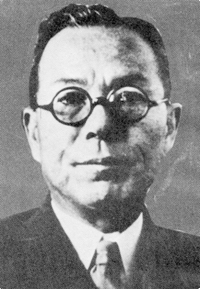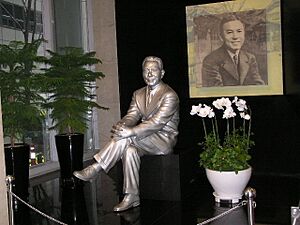Kim Seong-Su facts for kids
- In this Korean name, the family name is Kim.
Kim Seong-Su (Korean: 김성수; Hanja 金性洙, October 11, 1881 – February 18, 1955) was a very important person in South Korea's history. He served as the second Vice President of the Republic of Korea. Kim Seong-Su was also a politician, a teacher, and a journalist. He founded several well-known organizations, including the Kyung-Sung textile Co., the newspaper The Dong-a Ilbo, and Korea University. After he passed away, he was honored with the Order of Merit for National Foundation. He is also known by his pen name, Inchon (인촌; 仁村).
Contents
Life of Kim Seong-Su
Early Years and Education
Kim Seong-Su was born on October 11, 1891, in Gochang, Jeollabuk-do, South Korea. He studied Political Science and Economics at Waseda University in Japan. He graduated in 1914.
After returning to Korea, he took over Jung-Ang High School in 1917. The school was having money problems, and he became its president. In 1919, he started the Kyung-Sung textile Co.. His goal was to help Korea become economically independent from Japan. He also wanted to build up Korea's own businesses.
In 1920, he launched The Dong-a Ilbo, a major newspaper. He also took charge of Boseong College. This college later became the famous Korea University.
Activities During Japanese Rule
In 1938, Kim Seong-Su was involved with the Federation for National Mobilization of Korean. This group was seen as supporting Japan during its rule over Korea. He also wrote articles that seemed to praise student soldiers and the draft system for Japan.
Because of these actions, his name was included in a list. This list, released in 2008, named 3,090 people who were considered to have cooperated with Japan.
After Korea Gained Freedom
After Korea gained independence from Japan on August 15, 1945, Kim Seong-Su continued his work. In 1946, he became the leader of the Korea Democratic Party. He also became the ninth president of the Dong-A Ilbo newspaper.
He did not agree with the U.S. plan for South Korea to be under a "trusteeship." In 1949, he became a top leader of the Democratic National Party.
In 1951, he was sworn in as the second Vice President of South Korea. However, he resigned the next year. He disagreed with President Rhee Syng-man's strong, dictatorial style of leadership. After resigning, he became an adviser to the Democratic National Party. He continued to be active in the opposition party. In 1962, he was honored again with the Republic of Korea Medal of Order of Merit for National Foundation. This award was given to him after his death.
Related pages
- The Dong-a Ilbo
- Korea University
- Song Jin-woo
- Jungang high School
- Korean Democratic Party
- Rhee Syng-man
- Kim Gu
- Kim Kyusik
- Shin Ik-hye
- Chang Myun
- Yun Chi-Young
- Yun Chi-Ho
- Yun Posun
| Preceded by Rhee See-Young |
2nd VicePresidents of South Korea 1951 - 1952 |
Succeeded by Ham Tae-Young |



